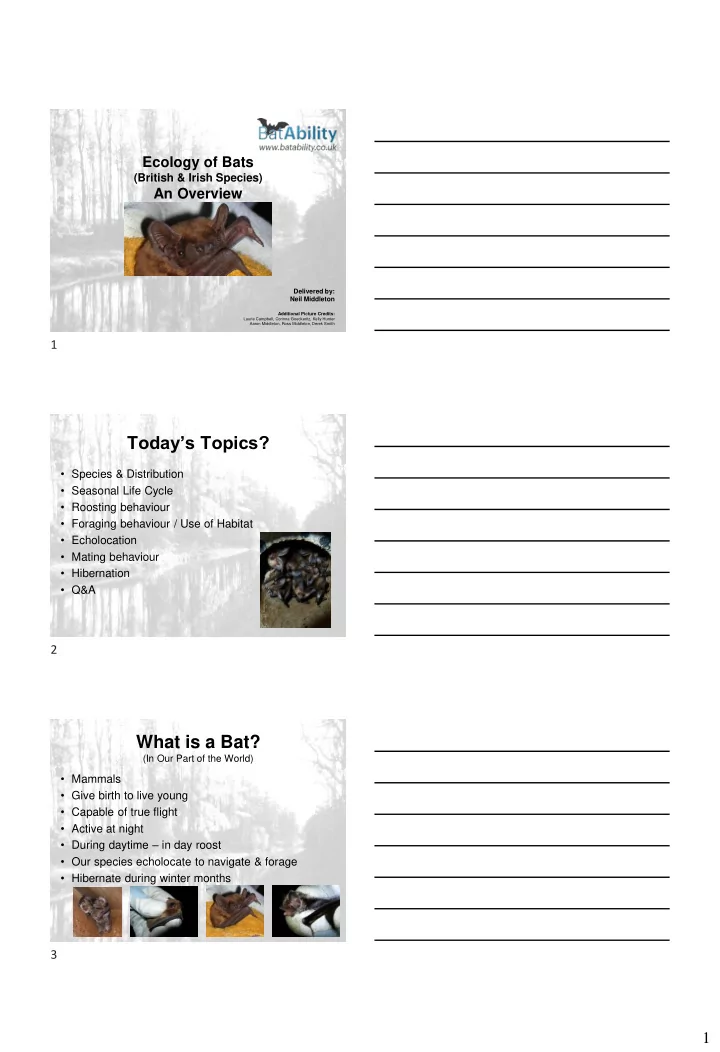

Ecology of Bats (British & Irish Species) An Overview Delivered by: Neil Middleton Additional Picture Credits: Laurie Campbell, Corinna Goeckeritz, Kelly Hunter Aaron Middleton, Ross Middleton, Derek Smith 1 Today’s Topics? • Species & Distribution • Seasonal Life Cycle • Roosting behaviour • Foraging behaviour / Use of Habitat • Echolocation • Mating behaviour • Hibernation • Q&A 2 What is a Bat? (In Our Part of the World) • Mammals • Give birth to live young • Capable of true flight • Active at night • During daytime – in day roost • Our species echolocate to navigate & forage • Hibernate during winter months 3 1
Species • c.50 Species of land mammal (UK & Ireland) • *34 Species of small mammal, **18 (53%) of which are bats • *Total population estimated at 175.5M • **Total bat population = 10.3M (6%) 4 Family Genus Species Status Distribution Rhinolophidae Rhinolophus Greater horseshoe Resident SW Eng, S Wales (Horseshoe Spp) Lesser horseshoe Resident W Ire, SW Eng, Wales Vespertilionidae Pipistrellus Common pipistrelle Resident GB, NI & Ireland (Vesper Spp) Soprano pipistrelle GB, NI & Ireland Nathusius’ pipistrelle Resident/ GB, NI & Ireland Passage Daubenton’s bat Myotis Resident GB, NI & Ireland Natterer’s bat Resident GB, NI & Ireland Whiskered bat Resident GB, NI & Ireland Brandt’s bat Resident England & Wales Bechstein’s bat Resident S England & S Wales Alcathoe Bat Resident England Plecotus Brown long-eared bat Resident GB, NI & Ireland Grey long-eared bat Resident S England & S Wales Nyctalus Noctule Resident Scotland, England, Wales Leisler’s bat Resident GB, NI & Ireland Eptesicus Serotine Resident S England & S Wales Barbastella Barbastelle Resident S England & Wales 5 Others Genus Species Kuhl’s pipistrelle Vagrants, Passage Pipistrellus Or Unknown Myotis Greater mouse-eared bat Pond bat Geoffroy’s bat Eptesicus Northern bat Vespertilio Parti-coloured bat 6 2
Seasonal Life Cycle Table taken from ‘Social Calls of the Bats of Britain & Ireland’ (Middleton, Froud & French, 2014) 7 Roosting Behaviour • Shelter from predation, weather, disturbance • Temperature, lux levels & humidity important • Use natural & man-made features • Use a number of roosts each year Table taken from ‘Social Calls of the Bats of Britain & Ireland’ (Middleton, Froud & French, 2014) 8 Roosting Behaviour 9 3
Foraging Behaviour & Use of Habitat Figure taken from ‘Social Calls of the Bats of Britain & Ireland’ (Middleton, Froud & French, 2014) 10 Linear Features • Act as reference points in the dark • Help to connect roosts with feeding areas • Smaller bats = ~extremely important • Removal = ~isolation/fragmentation • Sheltered flyways • Protection from predators • Provide foraging opportunities 11 Echolocation • The analysis by an animal of the echoes of its own emitted sound waves John D Altringham, Bats Biology and Behaviour • Micro-bats (old currency!) to navigate & forage (some cases!) • Sound travels at constant speed (340ms) • Bat is listening for how long it takes for sound to come back relative to when it was emitted • An ‘adaptable tool’ (It’s NOT bird song!) • Feeding Buzz = very fast echolocation • Social Calls are nothing to do with echolocating = Communication 12 4
Echolocation & Social Calls Examples 13 Mating Behaviour • Usually late summer through into autumn • May also occur over winter & during spring • Territorial behaviour can be evident • Pipistrellus/Nyctalus – territorial – advertisement calls can be heard • Purpose of these advertisement calls – twofold • Myotis – swarming 14 Mating Behaviour • Mating - late summer/autumn • Delayed fertilisation – store sperm & ovulate in spring • Nursery roosts May - Aug • Single pup born Jun - Aug • At birth pup weighs 20-30% adult mass • Weaning at 45-65 days Table taken from ‘Social Calls of the Bats of Britain & Ireland’ (Middleton, Froud & French, 2014) 15 5
Hibernation • Hibernation ~Oct – ~Mar • Lack of food in winter • Survive on stored fat • Need constant temp and high humidity • Body temp drops to just above ambient temp • Can take half an hour to arouse from deep torpor • ‘Classic’ & ‘Non - Classic’ roosting sites 16 Reference Material • Bats of Britain & Europe (Dietz & Kiefer, 2016) • British Bats (Altringham, 2003) • British Bat Calls – A Guide to Species Identification (Russ, 2012) • Social Calls of The Bats of Britain & Ireland (Middleton, Froud & French, 2014) • Ecology & Conservation of Bats in Villages and Towns (Simon, Hüttenbügel & Smit-Viergutz, 2004) 17 Thanks For Attending Today ^ ☺ ^ Contact Info: Neil Middleton BatAbility Courses & Tuition Email: neil.middleton@batability.co.uk R Mobile: 07877 570590 18 6
Q&A 19 7
Recommend
More recommend